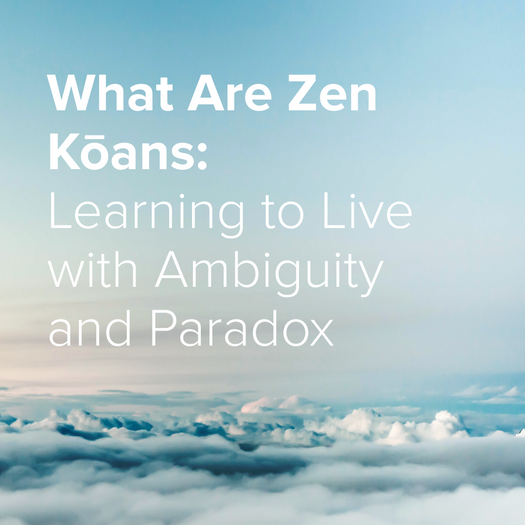Zen Kōans: Learning to Live with Ambiguity and Paradox

How do we explain the unexplainable? It’s a question that’s existed since time immemorial and given rise to legends, myths, and religious practices around the globe. A group of Chinese priests back in the 13th century decided to take this question a step further. They essentially asked: What if we didn’t need an explanation for everything?
This question gave rise to the birth of Zen kōans. Short statements (or questions) that are often a paradox, Zen kōans came about for the purpose of fostering contemplation. Used primarily in the Soto tradition of Zen Buddhism, they’re seen as a meditative technique to be used during zazen, Zen’s seated practice (3).

For our thinking minds designed to solve, kōans can be tough to wrap our heads around. And that’s exactly the point. They posit that there’s value in questions themselves without any answers, which runs counter to our logical way of thinking.
Essentially monks sit for extended periods of time contemplating these puzzles that can’t be solved. In this way, kōans serve to help monks live with ambiguity and paradox.
They also serve to help achieve a central tenet of Buddhism: letting go of binary thinking. Instead of focusing on right and wrong or black and white, kōans helped monks avoid clinging to answers or outcomes—because they lack them.
It’s in the practice of simply sitting and contemplating, that Zen monks believe they will learn bigger truths about themselves and the world (2).
Learn more about the Principles of Zen >
Perspectives on Zen kōans
Kōans themselves are meant to break the thinking mind and explanations of them can sound equally mind-boggling. It can be helpful to turn to Zen masters, authors, and contemporaries who’ve sat with kōans to hear their perspectives on what the puzzles are intended to do and the effects they’ve had on those trying to solve them.

Don Dianda
Author Don Dianda of See for Yourself: Zen Mindfulness for the Next Generation, offers his perspective:
“The kōan serves as a surgical tool used to cut into and then break through the mind of the practitioner… Kōans aren’t just puzzles that your mind figures out suddenly and proclaims, “Aha! the answer is three!” They wait for you to open enough to allow the space necessary for them to enter into your depths—the inner regions beyond knowing (2).”
Philip Kapleau
Zen Master Philip Kapleau shares that the period of despair is usually not short. Meditating on a kōan could keep a student sitting for hours, weeks, or months in contemplation.
“The role of the kōan is not to lead us to satori (enlightenment), but, on the contrary, to make us lose our way and drive us to despair (3).”
Alan Watts
The British-American philosopher Alan Watts helped bring these brain enigmas to a wider audience through his Zen-haiku-kōan infused beat poetry. He wrote that the kōans are not about asking impressive questions, but rather about guiding the student toward self-discovery:
“..not by looking out of the corner of your eye to see if everybody else is getting the same results as you or by trying to find out what others have already discovered. It is achieved by going down into one’s own inner, secret place, and asking there for a direct encounter with the world, independent of convention (3).”
Learn more about the Most Prolific Zen Masters >
Examples of popular Zen kōans
Of the 1700 kōans, you could spend a lifetime attempting to consider all of them (and perhaps another lifetime choosing where to start). There are a few popular kōans that can help you get your feet wet:
- When both hands are clapped a sound is produced; listen to the sound of one hand clapping (1).
- Out of nowhere, the mind comes forth (2).
- Two monks are arguing about a flag. One says, “The flag is moving.” The other, “The wind is moving.” A third walks by and says, “Not the wind, not the flag; the mind is moving (3).”
There is an idea in Zen that from emptiness, there is clarity. Koans are one tool to help you get to a place of emptiness. In this state, Zen Buddhists believe you’re able to see that the sense of self, for example, is only an idea (5). If you’ve ever been in a “flow” state, you may have felt something close to this. And though “flow” is not the same thing, there’s a similar feeling of selflessness and presence.

Dive deeper into your Zen practice
To continue your Zen journey, inside the Muse app our Zen teachers offer different perspectives and practices for living with more calm, happiness, and presence. In our Zen Collection, learn how to sit in the Zen style, explore the teachings of the Buddha, and discover how to apply these practices to your everyday life.
References:
- Koan | Zen Buddhism. Encyclopedia Britannica. https://www.britannica.com/topic/koan
- Kuruvilla, Carol. “These Zen Buddhist Koans Will Open Your Mind.” Huffington Post. https://www.huffingtonpost.ca/entry/zen-buddhism-koan_n_563251dce4b0631799115f3c?ri18n=true
- Beres, Derek. “10 Buddhist koans, and why understanding them is pointless.” Big Think. https://bigthink.com/culture-religion/what-is-a-koan?rebelltitem=2#rebelltitem2
- Li, Puqun. “Zen kōans: unsolvable enigmas designed to break your brain.” Ted-Ed. https://www.youtube.com/watch?v=9p5Oi4wPVVo
- The mysterious/unsolvable Zen Koans – Henry Shukman, associate master Sanbo Zen. The Kevin Rose Show. Apple podcasts. https://podcast.kevinrose.com/the-mysteriousunsolvable-zen-koans-henry-shukman-associate-master-of-sanbo-zen/

